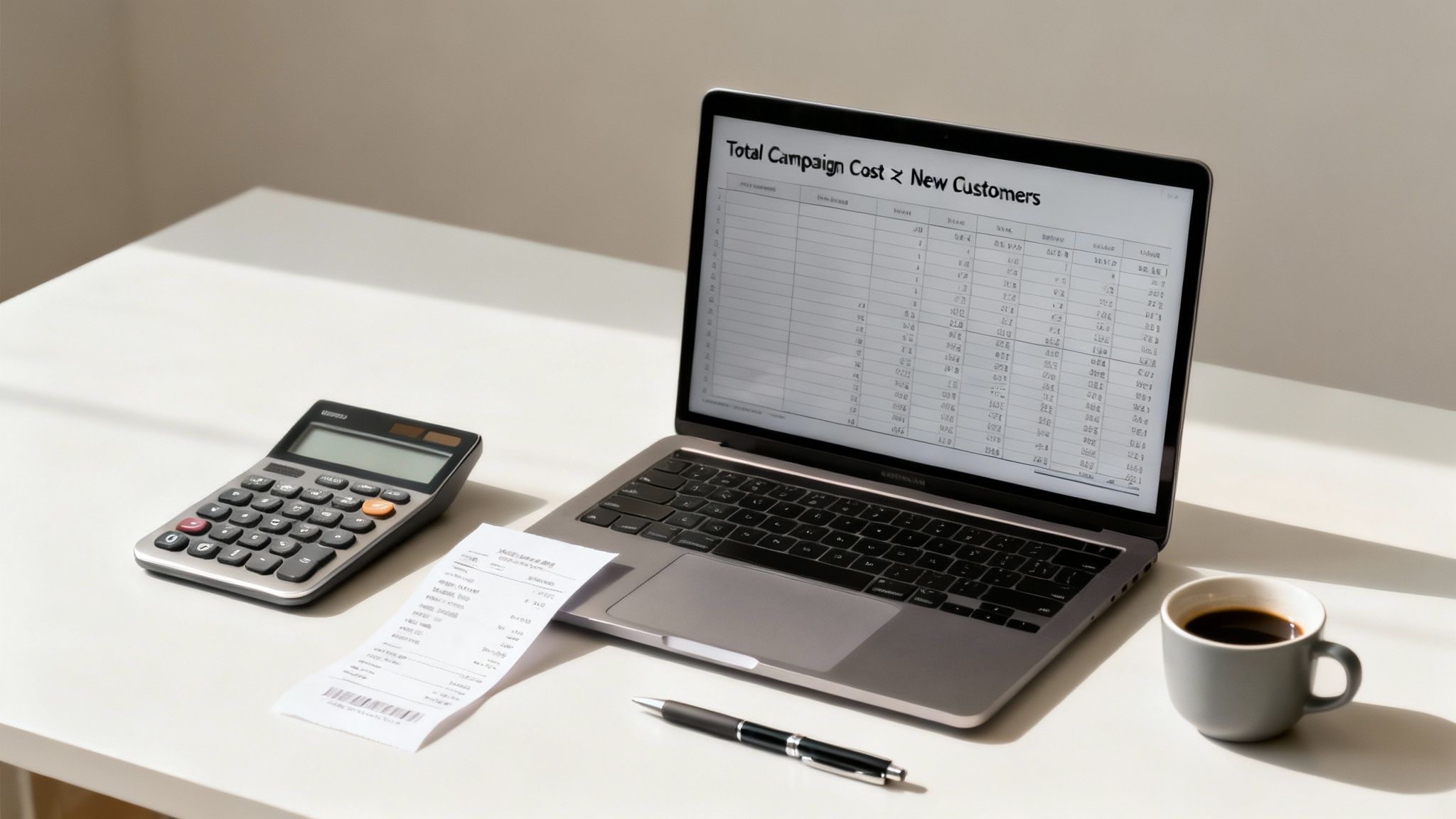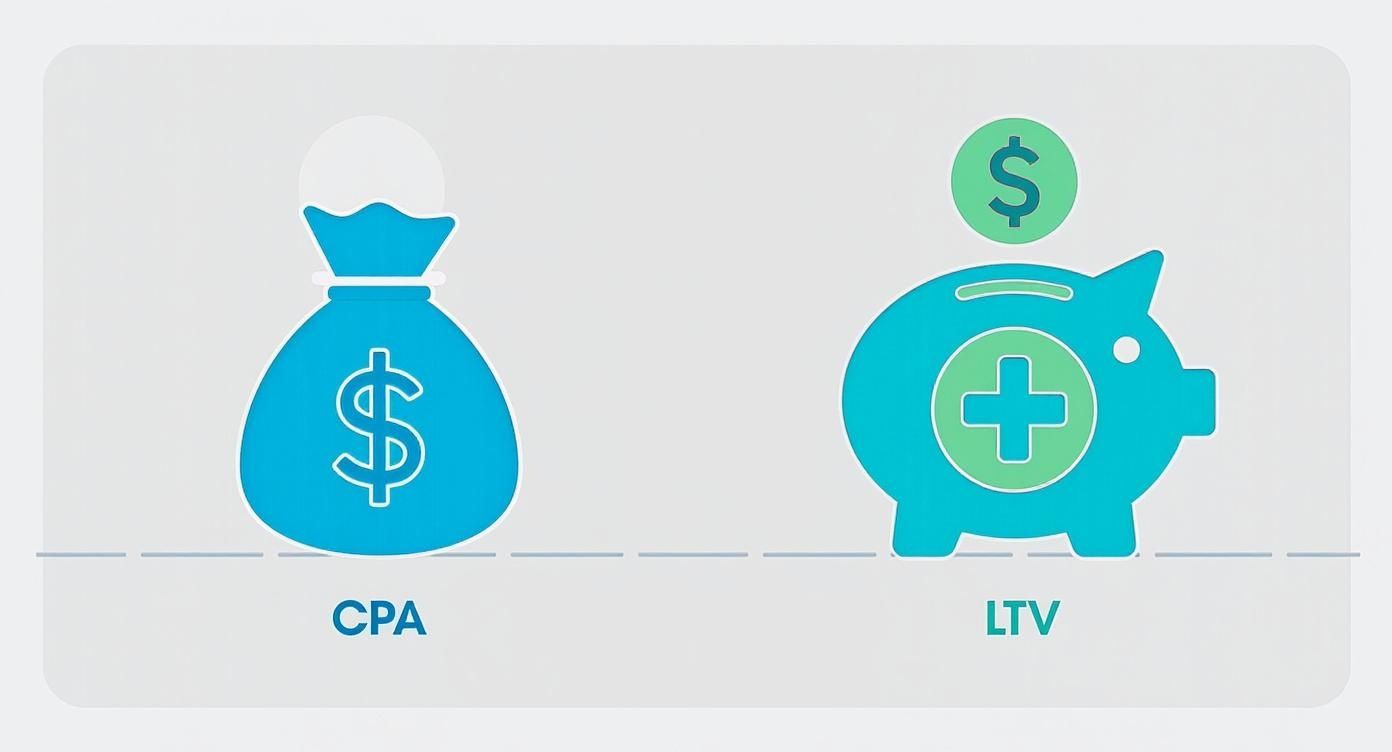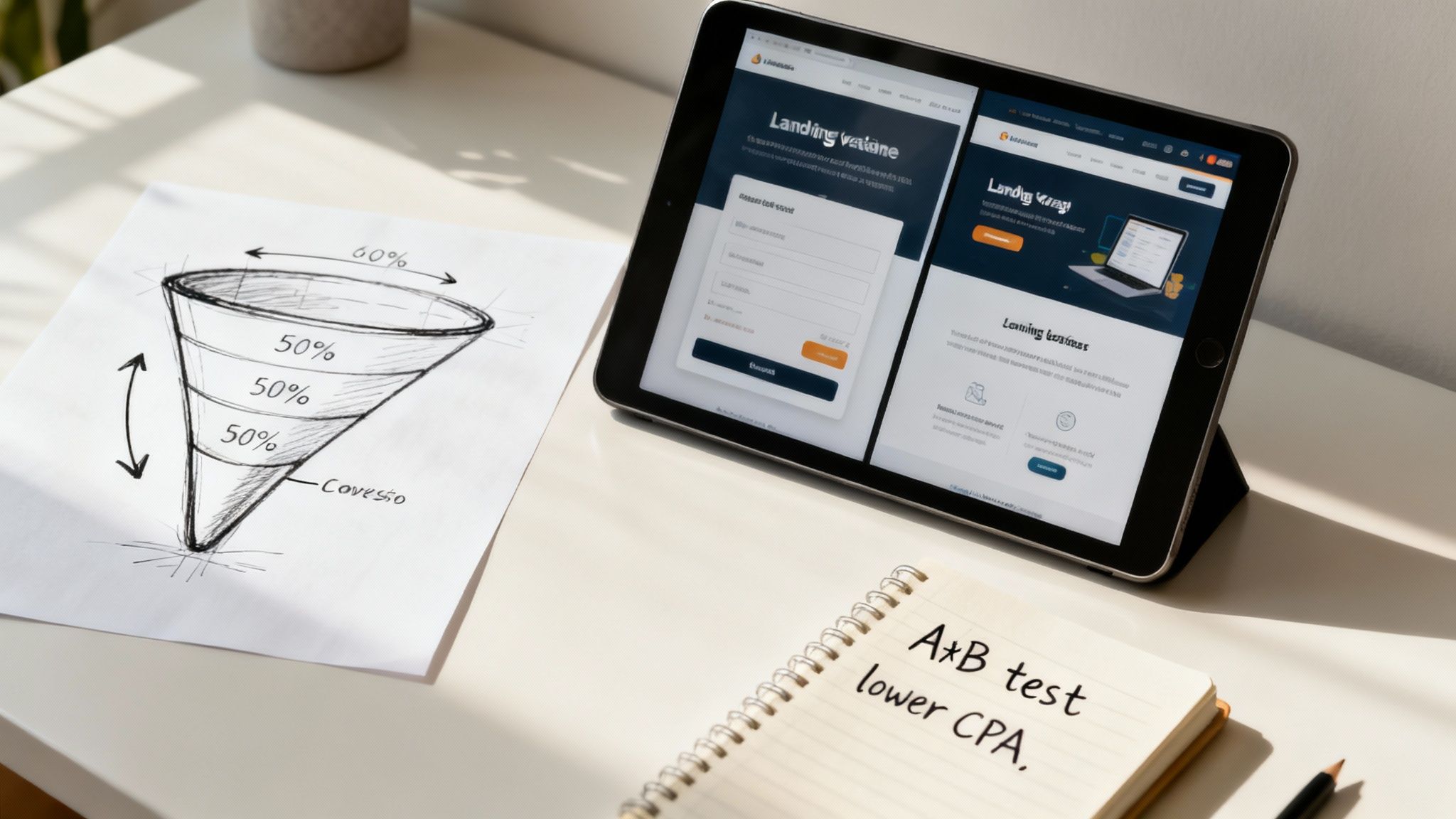Cost Per Acquisition, often abbreviated as CPA, is a marketing metric that measures the total cost a business pays to acquire a single new customer from a specific campaign or channel. In essence, it tells you exactly how much you're spending to turn a potential lead into a paying customer, making it a crucial indicator of marketing efficiency and profitability.
Understanding Cost Per Acquisition Beyond The Acronym

In a world filled with countless marketing metrics, CPA cuts through the noise to answer one fundamental question: "How much did we actually spend to win that single customer?"
Think of it like a fishing trip. You wouldn't just count the number of fish caught. To understand if the trip was worthwhile, you'd factor in the cost of fuel for the boat, the bait, and your equipment. Only then would you know the true "cost per fish."
The same logic applies to marketing. Your CPA isn't just your ad spend; it's a comprehensive measure that should account for all resources invested in a campaign, from creative production costs to the software used for management. Mastering this metric is the first step toward building a predictable and profitable growth engine.
Why CPA Is Such A Critical Business Metric
Knowing your CPA provides unparalleled clarity on your marketing efficiency. Without it, you’re essentially operating in the dark, allocating budget without a clear understanding of the return.
When you track CPA effectively, you can:
- Gauge Campaign Profitability: Determine if a marketing channel is generating a positive return or simply draining your budget.
- Optimize Your Budget: Confidently reallocate funds to high-performing campaigns and scale back on those with an unsustainable CPA.
- Sharpen Your Marketing Strategies: Identify which ads, keywords, or audience segments are most effective at converting prospects into customers.
CPA is more than a reporting metric; it’s a strategic compass. It guides your financial decisions, ensuring every marketing dollar contributes directly to sustainable business growth and a healthier bottom line.
To calculate CPA accurately, you must gather a few key pieces of information. It's not just about ad spend; a true calculation includes all associated costs that contributed to acquiring those new customers.
The Core Components of Your CPA Calculation
Breaking it down this way ensures no hidden costs are overlooked, providing a much clearer and more honest view of your marketing performance.
Connecting CPA To The Bigger Picture
Ultimately, CPA provides essential data that feeds into your entire business strategy, drawing a straight line between marketing activities and the revenue they generate.
For a truly holistic view, you must also consider how you assign value to each touchpoint in the customer journey. You can learn more about this by exploring what is marketing attribution and how it clarifies the impact of different channels. This complete perspective empowers you to make sharp, informed decisions that drive tangible results.
How to Accurately Calculate Your CPA

Understanding the concept of CPA is a good start, but its true value is realized when you can apply the formula to your own campaigns with confidence. While the basic equation seems simple, the details are what determine its accuracy—and overlooking them can lead to flawed conclusions.
Here’s the standard formula:
Total Campaign Cost ÷ Number of New Customers Acquired
Seems straightforward, but the integrity of your final CPA figure depends entirely on how you define "Total Campaign Cost" and "New Customers Acquired." A miscalculation here could lead to poor budget decisions based on a distorted view of your performance.
Decoding Total Campaign Cost
The most common pitfall is equating "total cost" with ad spend alone. This is a significant mistake. The true cost of acquiring a customer encompasses every dollar invested to launch and run the campaign. Ignoring these additional expenses will result in an artificially low CPA and a misleading sense of success.
To get the real number, your total cost should include:
- Direct Ad Spend: The money paid directly to platforms like Google, Meta, or LinkedIn.
- Creative and Content Production: Fees for graphic designers, copywriters, or video editors.
- Software and Tools: A portion of subscription costs for landing page builders, analytics platforms, or marketing automation software.
- Team Salaries: A prorated portion of the salaries for marketing team members who worked on the campaign.
- Agency or Consultant Fees: If you've hired external help, their fees are a direct campaign cost.
By aggregating these components, you build a comprehensive picture of your investment, which is the only way to determine if your campaigns are genuinely profitable.
Identifying Your Acquired Customers
The other side of the equation is equally critical: accurately counting the number of new customers. This requires precise tracking to ensure you only attribute acquisitions that came directly from the specific campaign being measured. Implementing robust Google Ads conversion tracking (or its equivalent on other platforms) is non-negotiable.
Let's walk through an example. Imagine an e-commerce brand runs an Instagram ad campaign for one month to promote a new product.
Calculate Total Cost:
- Instagram Ad Spend: $10,000
- Video Ad Creative (Freelancer): $1,500
- Landing Page Software (Monthly Cost): $200
- Marketing Manager's Time (Prorated Salary): $1,000
- Total Campaign Cost: $12,700
Count New Customers:
- Analytics and CRM data confirm the campaign generated 254 first-time buyers.
Calculate the CPA:
- $12,700 (Total Cost) ÷ 254 (New Customers) = $50 CPA
- A ratio below 1:1: This is a major red flag. You are actively losing money on every new customer.
- A ratio of 1:1: You are breaking even on acquisition, leaving no margin for other operational costs or profit.
- A ratio of 3:1 or higher: This is the target zone. It signals a profitable marketing engine and a solid foundation for scaling your business.
- Finance: $81.93 (Search), $56.76 (Display)
- Legal Services: $86.02 (Search), $39.52 (Display)
- Healthcare: $78.09 (Search), $72.58 (Display)
- Lookalike Audiences: Create new audiences modeled on the characteristics of your best existing customers.
- Layered Targeting: Combine multiple interest and demographic filters to create hyper-specific, high-intent audience segments.
- Ad Copy Testing: Constantly test different ad copy, headlines, and creative to identify which messages drive the most efficient conversions. A higher click-through rate often improves your Quality Score, which platforms like Google reward with lower costs.
If they had only used ad spend, their CPA would appear to be $39.37—a nearly 27% discrepancy. An error of this magnitude is large enough to fundamentally alter strategic decisions about future budget allocation.
Why CPA Is a North Star Metric for Growth
Tracking your Cost Per Acquisition is not merely an accounting exercise; it's a strategic compass that guides your business toward sustainable growth. While high revenue or lead volume can be encouraging, CPA is the metric that connects marketing expenditure to bottom-line results.
This single figure acts as a truth serum for your marketing efforts. It reveals which channels are efficiently converting investment into customers and which are underperforming. Without a firm grasp on your CPA, you're essentially guessing where to allocate your next marketing dollar.
Connecting Acquisition Cost to Long-Term Health
The real power of CPA is unlocked when you pair it with another key metric: Customer Lifetime Value (LTV). LTV represents the total revenue you can reasonably expect from a single customer throughout their entire relationship with your business.
Comparing these two figures provides the ultimate health report for your business model. The question becomes simple yet profound: are you spending less to acquire a customer than they are worth to you over time? This is the foundation of a scalable and profitable business.
The LTV to CPA ratio is the ultimate test of a scalable business. It moves the conversation from "How much did we spend?" to "Was that spending profitable in the long run?" A strong ratio means you have a repeatable, financially sound engine for growth.
The Ideal LTV to CPA Ratio
For most businesses, a healthy model is one where LTV is at least three times the CPA. This is often expressed as a 3:1 LTV:CPA ratio.
Achieving this 3:1 ratio ensures that each new customer not only covers their acquisition cost but also contributes to your company's overall profitability and future growth. Getting this dynamic right is mission-critical, and you can learn more about the other side of the equation in our guide on how to calculate LTV.
By shifting your perspective on what is cost per acquisition from a simple expense to a strategic growth lever, you empower your team to make smarter, data-driven decisions. This relentless focus on profitable acquisition separates businesses that merely survive from those that dominate their market.
What a Good CPA Looks Like Across Industries
Defining a universally "good" Cost Per Acquisition is impossible without context. It’s like asking, "How much should a vehicle cost?" The answer depends on whether you're buying a scooter or a spaceship. What constitutes an excellent CPA for an e-commerce brand could be a financial disaster for a B2B software company.
This variation is driven by factors like average product value, sales cycle length, and market competition. Understanding these industry benchmarks is crucial for setting realistic and achievable goals. For example, a high-ticket item can justify a much higher CPA because the eventual return on investment is significantly larger.
This infographic illustrates the critical relationship between the cost to acquire a customer (CPA) and the long-term value they bring to your business (LTV).

As shown, for a business to be profitable, the value a customer generates over their lifetime must substantially outweigh the initial acquisition cost.
Industry CPA Benchmarks
Data from pay-per-click (PPC) advertising reveals how dramatically these costs can vary. While the average CPA across all industries is around $59.18, this figure doesn't provide the full picture. A look at specific sectors is far more illuminating.
For instance, e-commerce businesses have an average CPA of $45.27 on search ads. In contrast, the technology sector faces one of the highest acquisition costs at $133.52 for the same channel, a difference driven by intense competition and high customer lifetime values.
Here’s a brief overview of average CPAs for other key industries:
These figures also highlight the importance of the marketing channel. A "good" CPA depends not only on your industry but also on where you're advertising. You can explore these numbers further in this detailed report on acquisition costs.
Ultimately, a good CPA isn't about hitting an arbitrary number. It’s about maintaining a healthy and profitable ratio between what you spend to get a customer and the lifetime value they bring to your business.
This industry-specific perspective helps you evaluate your own campaign performance more accurately and set targets that are both ambitious and grounded in reality.
Actionable Strategies to Lower Your CPA Today

Knowing your CPA is the first step; actively lowering it is what provides a true competitive advantage. The objective isn't simply to cut spending but to make every dollar work more efficiently. The goal is to acquire high-value customers for less, thereby maximizing your marketing budget's impact.
This requires moving beyond broad strategies to focus on precise, measurable optimizations. From refining ad targeting to perfecting the post-click experience, every incremental improvement contributes to a healthier bottom line.
Supercharge Your Landing Page Conversions
Your landing page is the final step between your ad spend and a new customer. A brilliant ad campaign is useless if the destination fails to convert. This is where continuous and methodical testing becomes your greatest asset.
By A/B testing elements like headlines, calls-to-action (CTAs), page layout, and forms, you can identify what truly motivates your audience. Often, a minor change—such as altering a button color or rephrasing a headline—can lead to a significant increase in conversion rates. As conversions rise, your CPA naturally falls. For a detailed guide on this critical process, learn how to optimize landing pages for better results.
Sharpen Your Ad Targeting and Creative
Showing ads to the wrong audience is one of the quickest ways to deplete your budget and inflate your CPA. Modern advertising platforms offer granular targeting options, allowing you to focus on your ideal customer profile with exceptional accuracy.
Avoid a "set it and forget it" mentality. Continuously refine your audiences based on demographics, interests, and online behaviors. Equally important is the use of negative audience lists to actively exclude users who are unlikely to convert, which can prevent significant wasted ad spend.
Here are a few tactics to implement immediately:
A lower CPA is the direct result of delivering the right message to the right person at the right time. Precision in targeting and creative isn't just a best practice; it's a financial necessity for efficient growth.
Build a High-Converting Remarketing Funnel
Most visitors will not convert on their first visit. Remarketing allows you to re-engage these "warm" leads who have already demonstrated interest in your offerings. This audience is invariably cheaper to convert than cold traffic.
The key is to segment your remarketing lists. For example, a user who abandoned a shopping cart is much closer to purchasing than one who only read a blog post. By targeting these segments with different, highly relevant ads, you can guide them back toward conversion. An effective remarketing funnel is a powerful tool for lowering your overall CPA by capturing high-intent users at a fraction of the initial cost.
Your Cost Per Acquisition does not exist in a vacuum.
It's easy to develop tunnel vision, focusing solely on your own campaigns and spreadsheets. However, your CPA is constantly influenced by broader market forces that are driving up acquisition costs for everyone.
Understanding this bigger picture is essential for building a resilient, future-proof acquisition strategy. It means recognizing these external pressures so you can navigate them effectively.
Competition and Privacy: The Great Squeeze
Two of the primary drivers of rising acquisition costs are increased ad competition and stricter data privacy regulations. As more businesses enter the digital advertising space, platforms like Google and Meta become more crowded, which naturally increases the price of ad placements.
Simultaneously, privacy laws like GDPR have fundamentally changed marketing. With less data available for precise targeting, campaigns can become less efficient, requiring more ad spend to achieve the same results. These two forces are squeezing marketers, making it more expensive than ever to capture a potential customer's attention.
The modern marketing challenge is to find precision and efficiency when both are becoming scarcer and more expensive. This makes a deep, honest understanding of your true cost per acquisition more critical than ever.
Why Your CPA Depends on Your Customer's ZIP Code
Geography plays a significant role in your CPA. Costs can vary dramatically between mature and emerging markets due to different levels of competition and local economic conditions.
E-commerce provides a clear example. While the average global customer acquisition cost for an online store is between $68 and $78, this figure masks significant regional differences. In the United States, brands targeting customers on the West Coast might pay up to 25% more than the global average due to intense ad competition. Conversely, costs in the Midwest may be 10-20% lower.
Meanwhile, the UK has experienced all-time high acquisition costs, fueled by economic pressures and stringent data regulations. To explore these regional trends, you can learn about the factors shaping e-commerce CAC and see how your market compares.
Common Questions About Cost Per Acquisition
Even with a solid understanding of the basics, a few common questions often arise as teams begin to analyze their cost per acquisition more deeply. Let's clarify these points to ensure you can move forward with confidence.
What Is the Difference Between CPA and CAC?
This is a common point of confusion. While CPA and Customer Acquisition Cost (CAC) are often used interchangeably, they represent different concepts.
Think of Cost Per Acquisition (CPA) as a campaign-level metric. It measures the cost to achieve a specific action, such as a free trial signup, a guide download, or a demo booking. It is tied to a single conversion point.
Customer Acquisition Cost (CAC), on the other hand, is a broader business metric. It calculates the total cost to acquire one new paying customer, encompassing all marketing and sales expenses over a given period. If a campaign's sole objective is to sign a paying customer, then its CPA and CAC might be the same. However, they are typically distinct metrics.
What Is a Good Cost Per Acquisition?
There is no single "good" CPA. Its value is relative to your Customer Lifetime Value (LTV). The true indicator of a healthy business is the LTV:CPA ratio. A 3:1 ratio is widely considered a strong benchmark.
A $150 CPA is excellent if the average customer generates $600 in lifetime profit. Conversely, a $30 CPA is unsustainable if your LTV is only $40. The best CPA is one that supports profitable, long-term growth.
Focusing on your own profitability is far more important than chasing a generic industry average.
How Should I Track My CPA?
Effective CPA tracking requires combining data from your advertising platforms with your own internal business intelligence.
Start by implementing essential tracking pixels, such as the Meta Pixel and Google Ads conversion tags. This provides direct, campaign-level performance data from the source.
Next, use a web analytics tool to understand the full user journey and determine attribution. Finally, integrate your ad platforms with your CRM. This critical step connects ad spend directly to actual revenue, providing a true, blended CPA and a clear view of your marketing ROI. It also helps you measure other key metrics, as detailed in our guide on how to calculate return on ad spend.
Ready to stop guessing and start driving profitable growth? At Twelverays, we build data-driven marketing strategies that lower your CPA and maximize your ROI. Get in touch with our experts today to see how we can help you achieve your business goals.





